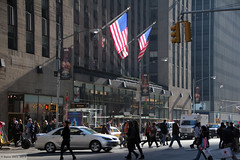South:Corner (790 8th Ave): Hilton Garden Inn Times Square, formerly Days Inn Midtown 242: The Mayfair Hotel was built c. 1900 as a hotel for actors; served as an SRO before being converted into a semi-budget hotel, noted for its tiny rooms. Eugene O'Neill Theatre230: Built in 1925 by the Shuberts, designed as usual by Herbert J. Krapp, it was originally named for Edwin Forrest, the 19th Century Shakesperean whose rivalry with William Charles Macready led to the Astor Place Riot of 1949. It was renamed first the Coronet in 1945 then the O'Neill in 1959, after the playwright. Tobacco Road played at the Forrest Theatre from 1934-41, prompting a sailor in On the Town to demand to be taken here. A Thousand Clowns debuted here, as did a number of Neil Simon plays--which makes sense, because for a time he owned the place. The Book of Mormon has been playing here since 2011. Time Hotel224: Built along with the theater next
door as the Hotel Forrest, where
Damon Runyon lived
from 1928 until the late 1930s. Other entertainers
who called this home include
Bert Lahr,
Jack Benny,
Fred Allen, and George Burns and Gracie Allen.
Later called the Hotel Consulate; got its current
name after a stylish makeover in 1999. Features the Time Lounge.
Crowne Plaza Manhattan
Corner (1605 Broadway): This 1989 building by Alan Lapidus stands out for its purplish glass and curved concrete corners. |
W
|
North:Corner: Gershwin Apartments are a 40-story apartment development built in 1998, named for the songwriting brothers. St Malachy's Church239: This neo-Gothic Roman Catholic church was built in 1902; the construction of an Actor's Chapel below the main church recognized its function as a spiritual home for Catholic show folk. Among the many who worshipped here were George M. Cohan, Spencer Tracy, Perry Como, Rosalind Russell, Danny Thomas, Bob Hope, Ricardo Montalban and Pat O'Brien. The funeral of Rudolph Valentino, held here on August 30, 1926, attracted 100,000 mourners. Joan Crawford, Fred Allen and Jimmy Durante were all married here. Malachy, a 12th Century archbishop of Armagh, was the first native-born Irish saint; according to a popular prophecy attributed to him, Benedict XVI is the next to last pope before the Second Coming. Ambassador Theatre219: Another theater designed by Herbert J. Krapp for the Shuberts, it opened in 1921. Bring in 'Da Noise, Bring in 'Da Funk played here from 1996-99. Brill Building
1619 (corner): Built in 1931 by developer
Abraham Lefcourt, it was soon taken over and renamed by the
Brill Brothers clothing store. In 1932, Southern Music
Publishing Company moved here, starting the building's role as a
center of music publishing that would last until 1974.
(Buddy Holly met his soon-to-be
wife,
Maria Elena Santiago, at Southern Music,
where she was a secretary.) Almost a third of the
songs played on Your Hit Parade from 1935 until 1958 were
published by Brill Building companies.
Songwriters like Carole King,
Burt Bacharach, Neil Diamond and Neil Sedaka got their starts here.
Big Bands like the Dorsey Brothers,
Guy Lombardo, Duke Ellington and Cab Calloway were also headquartered here.
On the ground floor, the Colony Music Center, with vintage vinyl and a great sheet music collection, is a reminder of the building's glory days. |










